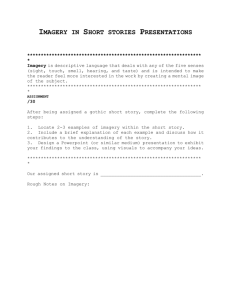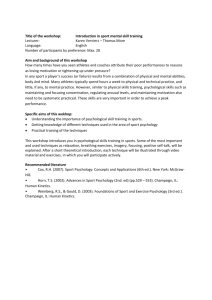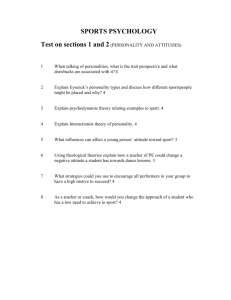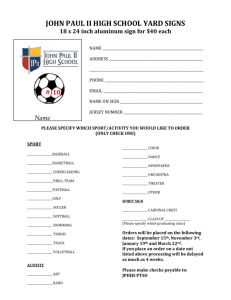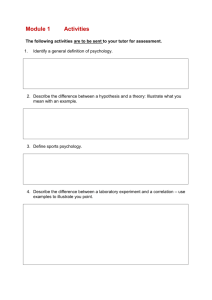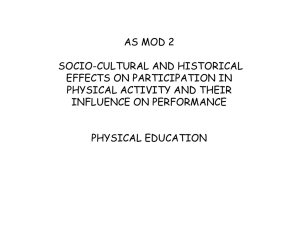2011 - Association for Applied Sport Psychology
advertisement
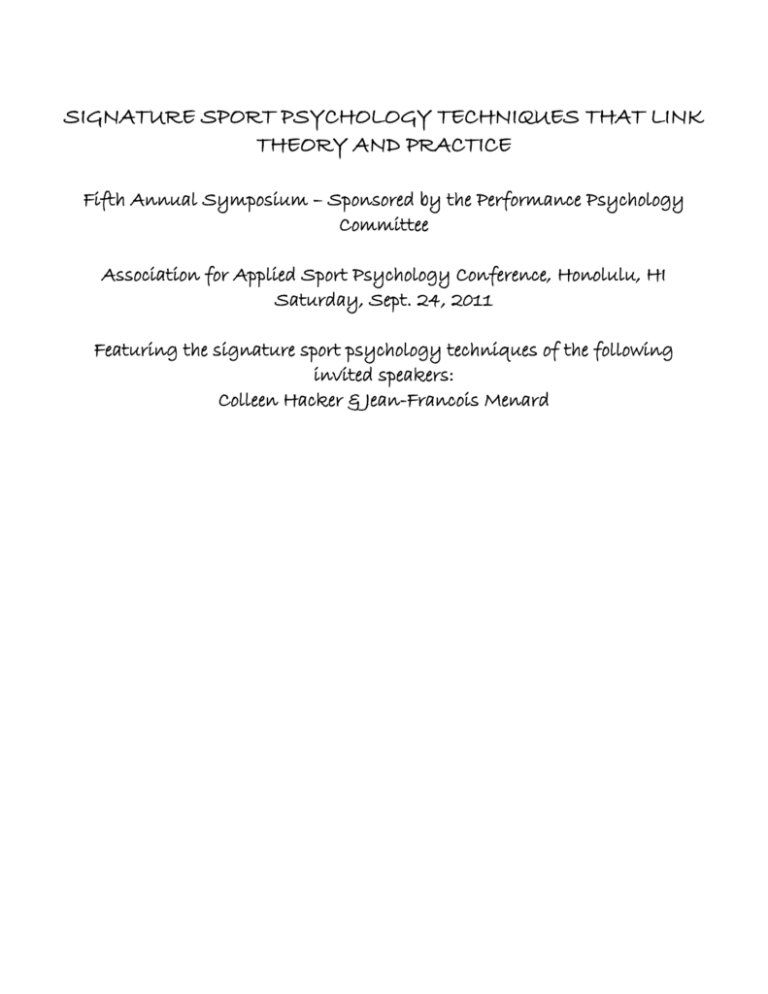
SIGNATURE SPORT PSYCHOLOGY TECHNIQUES THAT LINK THEORY AND PRACTICE Fifth Annual Symposium – Sponsored by the Performance Psychology Committee Association for Applied Sport Psychology Conference, Honolulu, HI Saturday, Sept. 24, 2011 Featuring the signature sport psychology techniques of the following invited speakers: Colleen Hacker & Jean-Francois Menard Create it, imagine it, do it: Imagery DVD training to enhance confidence among National Team soccer players Colleen M. Hacker, Ph. D. Professor, Movement Studies & Wellness Education Pacific Lutheran University Certified Consultant-ASAP, USOC Sport Psychology Registry The United States Women’s National Soccer Team (USWNT) is the only nation in the world to finish in the top three of every major international soccer event. The Team won the first Gold Medal awarded in women's soccer at the 1996 Olympic Games, followed by a Silver medal in Sydney then Gold and Gold again in the Athens and Beijing Olympic Games. As part of the most watched women’s sporting event in history, the Team was crowned World Champions (the second since 1991) with a dramatic, overtime victory in the 1999 World Cup. All five of the US players successfully converted their shots in the Penalty Kick shootout and the US goalkeeper made one dramatic save of a Chinese penalty kick attempt. Name and Purpose of the Technique a. Imagery, Confidence and Event Preparation DVDs b. This presenter will discuss the creation and use of individually-designed imagery DVDs to aid confidence, imagery training and overall mental preparation of the United States Women’s National Soccer Team. The imagery DVDs were just one aspect of a comprehensive psychological skills training program that included activation and relaxation techniques, imagery, concentration training, focus and distraction control strategies, mistake rituals, pre-practice and pre-competition routines, purposeful selftalk and performance cues, action plans for year-round training and competition and team building activities, to name a few. The imagery-confidence-event preparation DVDs fulfilled multiple functions. A partial list includes: to strengthen, maintain or regain confidence, accurately portray event characteristics, randomize mental rehearsal practice, enhance tactical preparation, highlight individual performance strengths and positional responsibilities, and highlight competitive self presentation. The imagery DVDs represented one of the signature tools developed for team members prior to each world event. Use of these tools was voluntary, individually tailored, event-focused, and designed in close collaboration with athletes, members of the coaching staff, and the mental skills coach. Theory The use of mental rehearsal as an effective tool in performance enhancement is well documented (Callow, Hardy & Hall, 2001; Gould & Maynard, 2009; Murphy, 2005). Many of the world’ s top athletes, including Kristine Lilly, Briana Scurry, Ronaldinho, Aaron Rogers, and Paula Radcliffe have attributed some of their success to the use of mental imagery. Self-confidence is also one of the most frequently cited factors influencing athletic performance and is believed to play a critical role in athletic success. Research has frequently shown that confidence is one of the distinguishing factors between successful and unsuccessful athletes (Beauchamp, Bray & Albinson, 2001; Zinsser, Bunker & Williams, 2010). Creation of the DVDs were constructed following Bandura’s Self Efficacy Theory (1986), Vealey's (2001) Integrated Model of Sport Confidence, and the extensive research on the relationship between imagery and self confidence (Feltz, 2007; Feltz & Landers, 2007; Hall, Mack, Paivio & Hausenblas,1998; Vealey & Greenleaf, 2010; Zinsser, Bunker & Williams, 2010). Application Samples of National Team members' imagery DVDs will be used to illustrate the application of theory into authentic and successful practice with a group of elite level athletes. Four W's of Imagery (Munroe, Giacobbi, Hall & Weinberg, 2000) 1. What (correct, successful, positive, controllable, accurate, poly sensory, emotionally accurate and vivid) 2. Where (practice & competition) 3. When (prior to competition) 4. Why (imagery function) PETTLEP Model (Holmes & Collins, 2001; Smith, 2011) 1. Physical- as close to the physical experience as possible 2. Environmental- as similar to the performance environment as possible 3. Task- as similar to the competitive task as possible 4. Timing- as close to “real time” as possible 5. Learning- as similar to actual cognition and feelings as possible 6. Emotion- as realistic to performance emotions as possible 7. Perspective- internal or external depending on the function Paivio's (1998) Two-function, Analytical Framework for Imagery 1. Cognitive Function (cognitive specific and cognitive general) 2. Motivational Function (goals and actions and physiological activation and affect) Based on Vealey et al., (1998) Integrated Model of Sport Confidence Nine Sources of Self Confidence 1. Mastery 2. Demonstrate ability 3. Physical/mental preparation 4. Physical self presentation 5. Social Support 6. Vicarious experiences 7. Coach's leadership 8. Environmental comfort 9. Situational favorableness Imagery DVD Content Considerations “Bookends”: past success & current championship National Anthem Emotion Leadership Communication MST Techniques Random Order Real Time & slow motion, various angles Not all highlights (Recovering after mistakes) Impact on opponents Personal stats Family & fans Teammates Various weather conditions & time of match Various field conditions Various crowd size Self Presentation (Body language) Entering and leaving the field THE competition stadium(s) Physical risk & injury “Hustle Stats” Team stat action clips (service behind the 18, first balls won, etc.) TEAM focus behaviors Set Pieces What your actions make possible for teammates Closed AND open skills Stoppages in time “Communication” with the coach and bench References Bandura, A. (1986). Social foundations of thought and action. Englewood Cliffs, NJ: Prentice Hall. Bandura, A. (1997). Self-Efficacy: The exercise of control. New York, NY: W.H. Freeman and Company. Feltz, D. (2007). Self-Confidence and sports performance. In D. Smith and M. Bar-Eli (Eds.), Essential Readings in Sport and Exercise Psychology (pp. 278-294). Champaign, IL: Human Kinetics Publishers. Morris, T., Spittle, M. & Watt, A. (2005). Imagery in sport. Champaign, IL: Human Kinetics Publishers. Munroe, C., Giacobbi, P.R., Hall, C., & Weinberg, R. (2000). The four Ws of imagery use: Where, when, why and what. The Sport Psychologist, 14, 119-137. Murphy, S., & Martin, K. (2002). The use of imagery in sport. In T. Horn (Ed.), Advances in sport psychology (2nd ed., pp. 152-166). Champaign, IL: Human Kinetics Publisher. Paivio, A. (1985). Cognitive and motivational functions of imagery in human performance. Canadian Journal of Applied Sport Sciences, 10, 22-28. Tracey, J. (2011). Benefits and usefulness of a personal motivation video: A case study of a professional mountain bike racer. Journal of Applied Sport Psychology, 23, 308-325. Weinberg, R.S., & Gould, D. (2007). Foundations of sport and exercise psychology (4th ed.). Champaign, IL: Human Kinetics Publisher. Vealey, R. (2001). Understanding and enhancing self-confidence in athletes. In R. Singer, H. Hausenblas & C. Janelle (Eds.), Handbook of sport psychology (2nd ed., pp. 550-581). New York, NY: John Wiley & Sons, Inc. Vealey, R., & Greenleaf, C. (2010). Seeing is believing: Understanding and using imagery in sports. In J. Williams (Ed.), Applied sport psychology: Personal growth to peak performance (6th ed., pp. 267-304), New York: McGraw-Hill. Tuning In! Reconnecting the “Here and Now” in Training and Performance Jean François Ménard Performance Psychology Advisor Cirque du Soleil Inc. Introduction The acrobats who join Cirque Du Soleil originate from all corners of the world and come from a wide range of backgrounds, like gymnastics, trampoline, and acro-sport, just to name a few. Most of them have over 10 to 15 years of experience at the elite level which makes them experts in their own fields. They arrive in our training programs with a very high caliber of acrobatic skills and with strong psychological abilities to perform. During a training program there is a multidisciplinary team of specialists such as acrobatic coaches, artistic coaches, a nutritionist, performance medicine professionals, and a performance psychology advisor, that assist the artists in their daily activities to facilitate their development. One important reality the artists face in our environment is that they need to adapt their skills, through specific acrobatic and artistic training, to meet the requirements of excellence needed to perform in our shows. Keep in mind that a Cirque Du Soleil artist can perform up to 400 shows in a year. This is very different for an athlete like a gymnast who is accustomed to train almost every day of the year and have only occasional performances. Plus learning to act on stage and sharing it with other performers is also a new reality for many athletes coming from the world of sport. Coming to work for Cirque Du Soleil really is a big transition in an individual’s career, especially for former athletes. As a result, all of this can demand a great deal of adaptation for an acrobat that is learning to become an artist in our training program. This presentation will highlight a few strategies to improve concentration skills, more specifically connecting with the present moment, which can play an important role in the effectiveness of their development during this adaptation phase. Finding the “Here and Now” The Here and Now (H&N) is a particular moment performers thrive to attain, where thoughts, emotions, and actions all come together in perfect harmony. Performing in the H&N remains, for some people, a skill that is easier said than done. Hypothetically, no physical performance really happens outside the present moment as the performer’s physical body can only perform in the NOW. The body can’t perform in the past; the body can’t perform in the future. The mind, on the other hand, is the only dimension in performance that can make an artist get out of the H&N. In other words, only the mind can get into the body’s way. However, for performers who train their mind-body connection on a regular basis, the H&N becomes more known to them. Consequently the more they practice being in the moment, the more it becomes natural when they need it in their daily acrobatic and artistic training sessions. There are common factors that in our training program environment that can disrupt a performer’s attention. Examples vary from being push out of your comfort zone on a daily basis as much in artistic than acrobatic work, adapting to new apparatuses, working with people speaking different languages, and learning several new skills in a short period of time. Because of situations like these, being able to reconnect with the present moment becomes vital when looking to reach high standards in performance. Techniques to help circus performers connect better with the H&N Most artists already have tremendous focusing abilities. However, our context at Cirque Du Soleil demands learning new skills or adapting already acquired skills. Consequently artists can sometimes over-think and get distracted. Here are a few techniques and strategies that can aid artists to refocus which can have a direct effect on their learning progression in our training programs. 1) Controlled breathing (adapted from Williams (2006) and Mason (1980)) a) Proper controlled breathing is an essential technique to find the H&N. By bringing attention to your breath, you automatically bring your attention to the present moment. You can’t breathe in the past nor can you breathe in the future. You always breathe in the NOW. Plus, controlled breathing soothes the nervous system, calms, steadies, and clears the mind. It also reduces muscle tension, and most importantly, is an efficient method to connect the mind to the body. Stuck in the past Stuck in the future HERE andNOW b) Some performers get distracted because they provide too much energy to useless thoughts or to troubling emotions. This in turn can keep performers trapped in the past or caught in the future. In other words, they think too much and consequently can get stuck in their heads. A helpful trick is to bring attention to belly breathing so performers can “get away” from their heads. This strategy is practical because it acts as an attention and energy shifter. 2) ACROnyms for ACRObats (adapted from Heath & Heath (2007)) Another helpful technique is using constructive keywords in self-talk to guide thoughts directly to the task at hand. Acronyms are a great way to remember and utilize keywords. It is important to come up with words that performers will remember easily and that are significant to their needs. To come up with sticky acronyms, make the artists talk on how they want to feel/behave/think during an optimal performance or how they want to bounce back from a mediocre performance. Then, listen carefully to what they say and work together to find an acronym based on their own words. Some examples of acronyms are BLT (Breathe Loose Trust), GPS (Go, Power, Strong), CPR (Calm Present Ready), TMN (Trust Myself NOW), and CBS (Come Back Strong). The more creative and personalized the acronyms are, the more likely they will stick to their brains. 3) The VELCRO effect (adapted from Tolle (2004)) This happens when a performer provides a considerable amount of attention to a past performance when he is about to engage into another skill. This means a good portion of the performer’s attention is still stuck on the past and only limited attention is geared directly towards the skill to perform in the H&N; hence the name the VELCRO effect. The performer is hooked and attached onto the past performance and is unable to let go. The artist needs to unhook from the past so they can find the H&N better. This technique is done by using visual props or by drawing on a board so the performer can see the past being velcro-ed to the present. With better visual awareness of the actual situation, the artist then understands better how the past may affect the present task. A few examples will be given during the presentation. Conclusion Artists find these techniques practical because they are easy to remember, simple to use and practical in their everyday activities. As well, visual tricks are especially practical when working with foreign artists who do not speak English. It is important for performers to practice these refocusing techniques on a daily basis so it becomes more and more automatic when they need it during moments of distractions. Let’s not forget that being in the H&N is a skill. Like any other physical or tactical sport skill, it should be part of a performer’s daily training regimen or it will not improve. Contact Information Email address: jean-francois.menard@cirquedusoleil.com References Heath, C., & Heath, D. (2008). Made to stick. London: Arrow Books Mason, L.J. (1980). Guide to stress reduction. Culver City: Peace Press Tolle, E. (2004). The power of now: A guide to spiritual enlightenment. Vancouver: Namaste Publishing Williams, J.M. (2006). Applied sport psychology: Personal growth to peak performance. New York: McGraw Hill * J.F. Menard graduated from the University of Ottawa with a Masters Degree in Sports Psychology.

